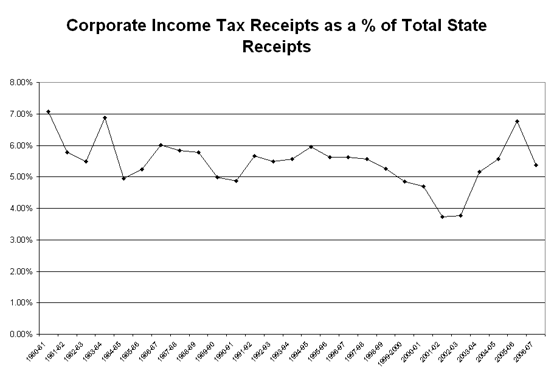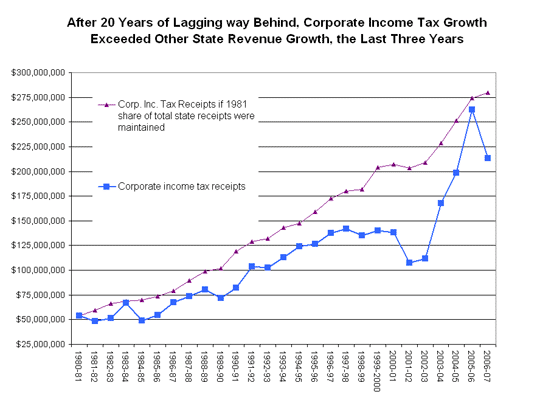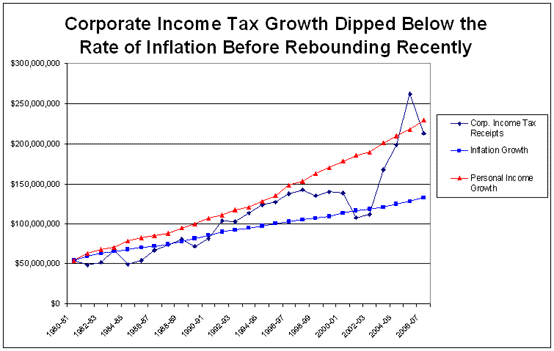
Taxes in Nebraska > Sources of Major State and Local Taxes > Income Tax > Corporate Income Tax Receipts, the Economy and State Tax Receipts
CORPORATE INCOME TAX RECEIPTS, THE ECONOMY, AND STATE TAX RECEIPTS



| Some activity on the chart above -- such as spikes and troughs -- can be traced to policy decisions made by the Legislature. To view additional information about these changes, click on a bill number below. A chronology of legislative action will open in a new window; the bill you selected will be viewable at the top of the new page. | |
| YEAR | LEGISLATIVE ACTIVITY |
| 1984 | LB 1124 |
| 1987 | LB 775 | LB 772 |
| 1990 | LB 1059 |
| 1991 | LB 829 |
| 1995 | |
| 2005 | LB 312 |
|
The charts above show that for nearly all of the study period the corporate income tax declined dramatically as a share of the economy and Nebraska's tax mix. Tax receipts lagged the growth in the economy through the 1990s despite the rate increases that have taken place since 1980, especially LB 1059 (1990). LB 829 (1991) adopted a number of one year tax increases, including a corporate income tax surcharge and a depreciation surcharge to fund replacement revenue for a one year exemption of the personal property tax. This increase is also visible in the chart. However, unlike the individual income tax part of our tax system which naturally grows faster than the economy, the corporate income tax system has not. The legislative changes in the chronology explain part of the reason why. LB 775 (1987) is an investment incentive program that results in more than $50 million in income tax credits used by qualifying companies every year. LB 1124 (1984) changed the apportionment of the income of multistate unitary businesses from worldwide to nationwide combined reporting after a Nebraska Supreme Court ruling held the prior practice to be unconstitutional. LB 772 (1987) phased in sales-only apportionment of the income of multistate unitary businesses and LB 559 (1995) phased out the throw-back rule. Under the sales-only apportionment method, the income of a multistate business is taxed by Nebraska based on the amount of sales made in the state. The previous system apportioned income to Nebraska based on the average of three factors, sales in the state, property employed in the state and the payroll paid in the state. Prior to the passage of LB 559 (1995), sales made from a Nebraska location into a state which cannot constitutionally tax the company because it has insufficient contacts with that state were considered Nebraska sales. Enactment of LB 559 phased out the "throw back" rule over three years. However, this declining importance of the corporate income tax is not unique to Nebraska tax policy. Other states are also relying less on the corporate income tax than they previously have. According to many experts, the contribution of the corporate income tax to state revenues has declined by half in the last 30 years (State Tax Review, July 22, 2002). In addition to the greater use of employment and investment incentives, causes include more aggressive state tax planning by the corporations themselves and a greater use of other forms of business organization, like joint ventures, corporate partners, and L.L.C.'s. Beginning in fiscal year 2003-04, corporate income tax receipts grew at a very high rate for three years, faster than any other source. This observation broke a long string of declines and may have been an aberration. Results for FY2006-07 show a declining share and may be a resumption of the old trend. |